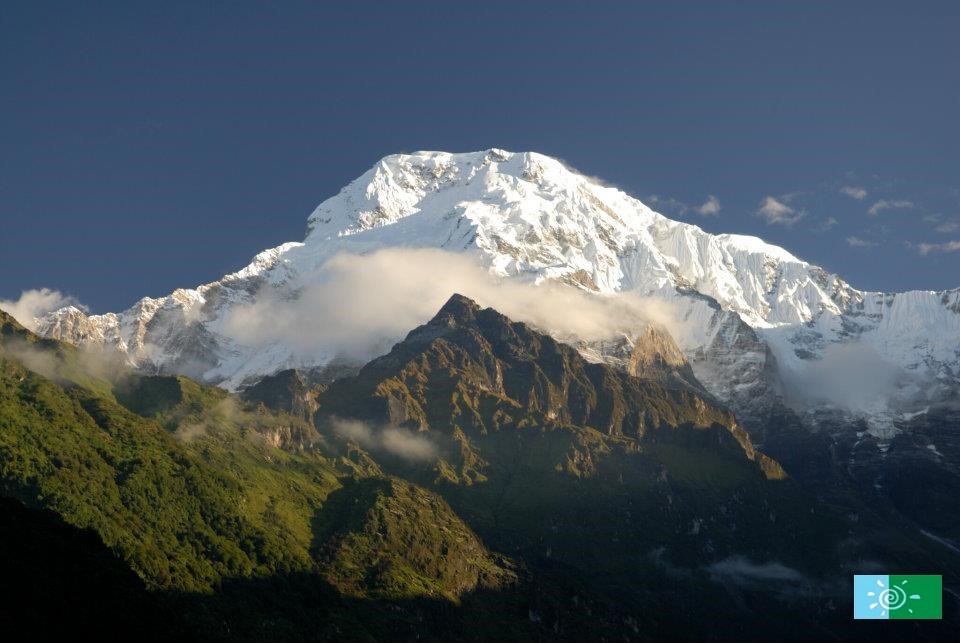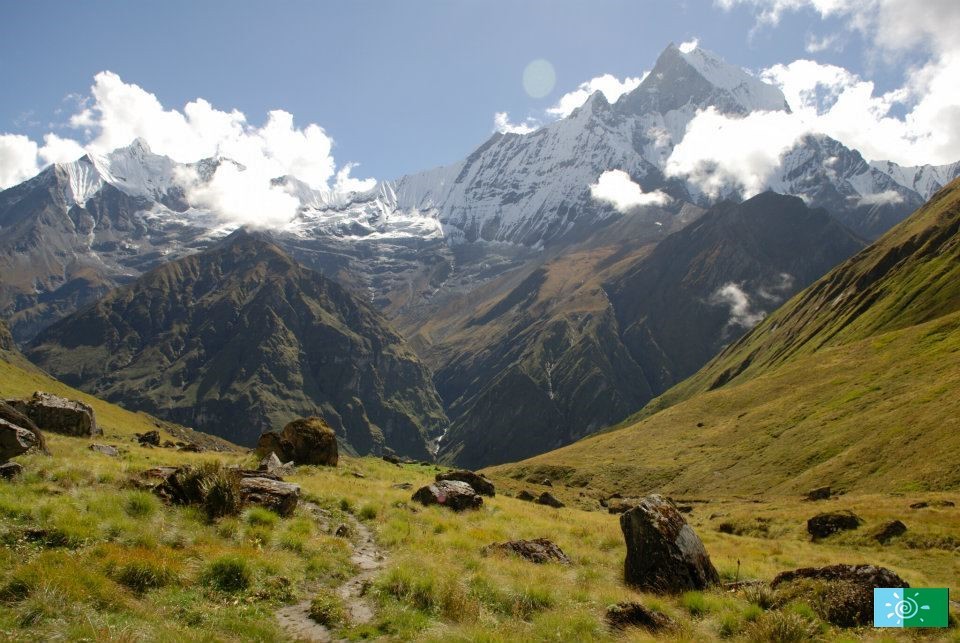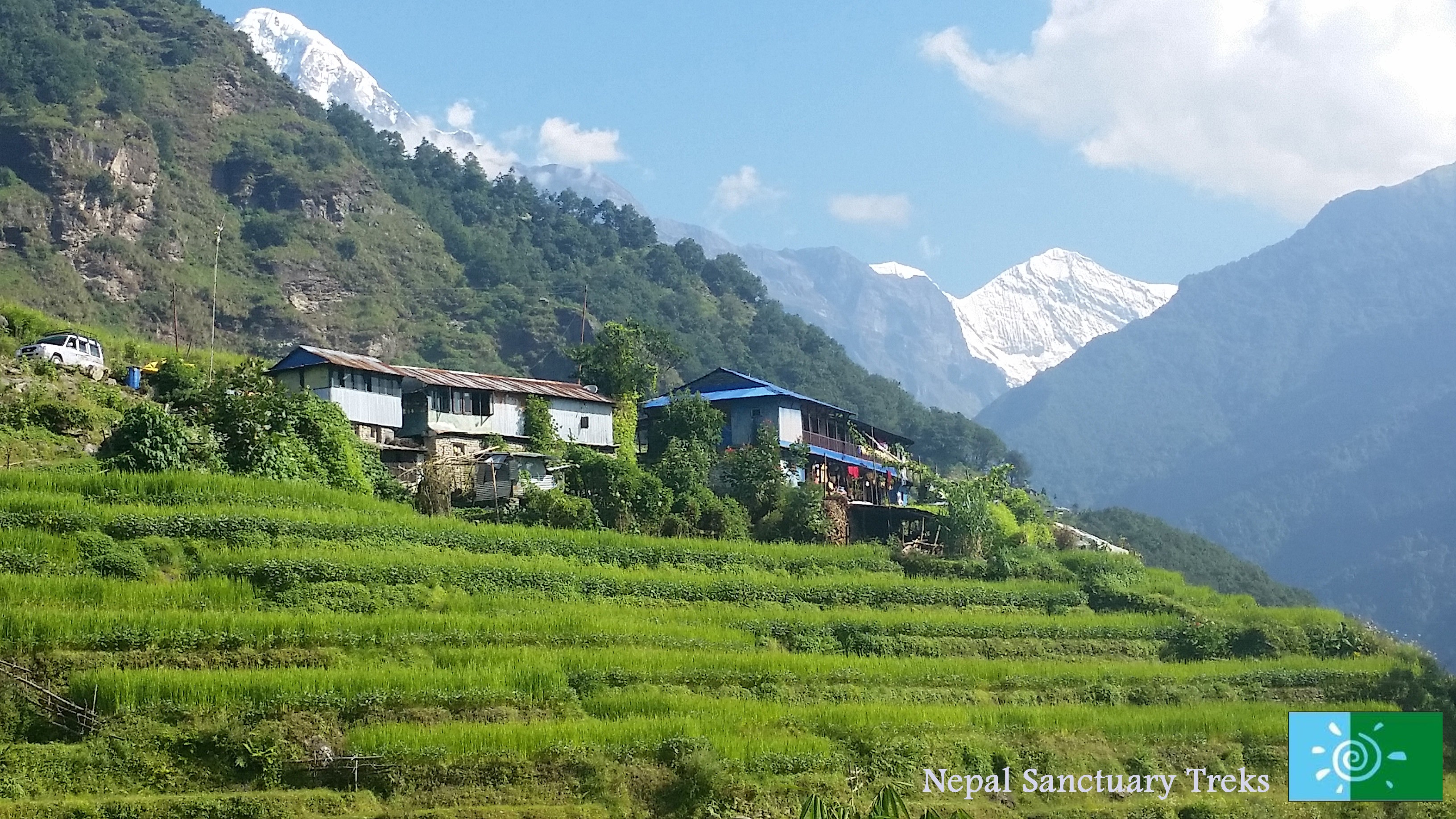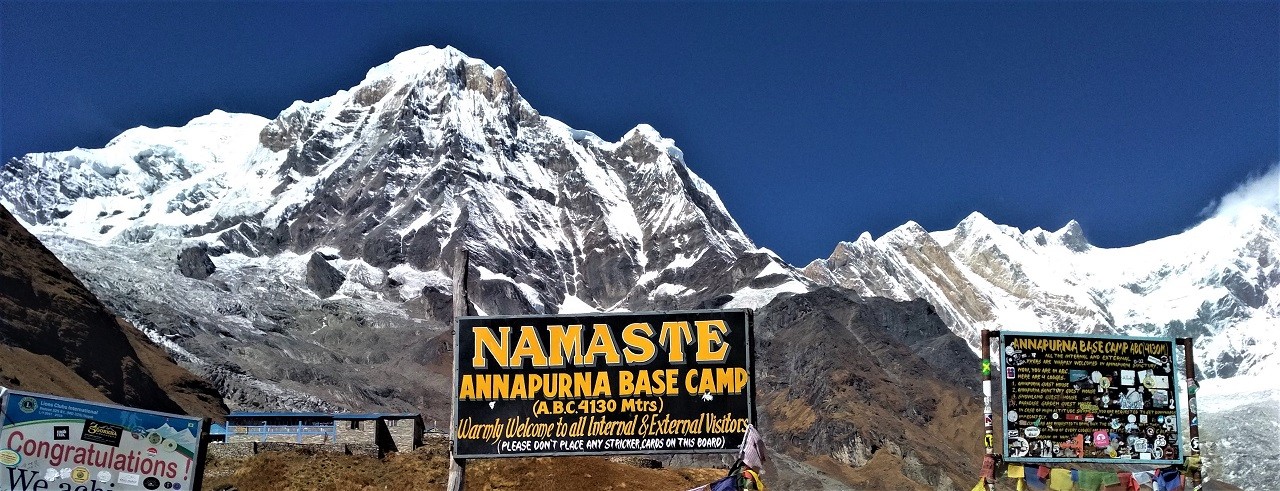Trekking in mountains is a wonderful experience to get in life. The Mount Annapurna (8,091 m) is the 10th highest mountain in the world and the trek to Annapurna Base Camp (4,130 m) is one of the best trekking destinations not only in Nepal, but also among the best trekking destinations that ever existed on earth.
In recent years, the number of trekkers to the Sanctuary has increased substantively, in part because the Sanctuary forms the base of one of the major routes to the peaks of the Annapurna range. The Annapurna Sanctuary is now part of the Annapurna Conservation Area Project.
When it comes around trekking in Nepal, then trekking around the Annapurna Base Camp is never a bad idea. The Annapurna Base Camp Trek takes you to experience the beautiful mountains of Nepal. The typical Nepali villages, local people and their lifestyle are yet other aspects to enjoy during the trek.

Breathing the pure and fresh air, the classic trek to Annapurna Base Camp is the trail that leads to the magnificent mountains that touch the horizon. The spectacular Annapurna II, Annapurna III, Annapurna IV, Annapurna South, Tent Peak, Hiunchuli, and Gangapurna warmly welcome the trekkers with their white beauty. The diverse landscape and the mountain culture will never let you forget the trip in your lifetime.
Trek Highlights
- Ace to the highest Point Annapurna Base Camp (4,130 m)
- Explore charming Gurung village Ghandruk and Chhomrong
- Unobstructed views of Himchuli , Annapurna South, Barahi Shikhar, Annapurna I, Glacier Dom, Gangapurna , Annapurna III and Machhapuchhare
- Walk through pine and rhododendron forests
- Pass through picturesque village and cultivated fields
- Scenic flight to and from Pokhara
- Splendid views of sunrise from Poon hill
- If you are lucky you might encounter with musk deer, Ghoral, pheasant
- Enjoy the melodious sound of varied range of birds.
- The unique and remarkable experience of natural and cultural splendor
Exciting to Trek Around the 10th Highest Peak in the World?
People and Local Culture
Along the trail to Annapurna Base Camp, trekkers will encounter people with various ethnic groups. The lower elevation is populated mainly by the Brahmins and the Chhetries. As we ascend towards the higher elevations, we will find the Gurung and Magar people. These people have a history of bravery for being a part of the Gorkha Army in the ancient time. The Mongoloid Himalayan people live in the Himalaya. The pretty village women folk will welcome you with their smile no matter what they are busy with.
Annapurna Base Camp: Getting to and Back
The trek to Annapurna Base Camp starts and ends in Pokhara. The beautiful city of lakes is situated 200 km west from Kathmandu and is an excellent place to relax you after a long hike to Annapurna. Pokhara is easily accessible from the capital city of Nepal; Kathmandu by both roadways and airways.
The trek actually varies from 7 to 12 days to/from Pokhara and 2 to 4 days transportation day to/from Kathmandu. The physical fitness of the trekkers also makes a great difference. The most common route to Annapurna Base Camp is via Ghorepani Poon Hill. The trekking route is relaxing and also settles the trek in between 10 to 12 days.
The trek can be started from Syabru Besi and following Rimche to reach Langtang. The trekkers then follow the Kyangin Gompa, Chergo RI towards Thulo Syabru, Sing Gompa and Gosaikunda Lake and then returning back to Kathmandu via Dhunche.
Best Time to Trek in Annapurna Base Camp
Autumn (mid-September to mid-December) and spring (March to May) are the best seasons to trek to Annapurna Base Camp. The time between June and August receives frequent rainfall thus can hinder the mountain views. However, this part of the year can be important for the botanist since the plants regenerate.
The spring offers the trekkers with the beautiful bloom of the rhododendron flower. When the rays of the sun strike on the surface of the Mount Dhaulagiri, it feels like there could be no heaven more beautiful than this. Although the autumn and spring are the peak trekking seasons, trekkers can also go during the winter (December – February) if they prefer to avoid the crowd. The only thing about trekking in winter is that the weather is colder.
Requirements for the Trek: Physical Conditions and Experience
Talking about the difficulty of the trek, the trek to Annapurna Base Camp is a moderate trek which does not consist of any vertical climbing. Thus, the trek does not require advanced physical conditions and experiences. Anyone who loves walking in nature and with an average fitness level can easily accomplish the trek. The trekkers must be passionate about the walk and determined to walk almost 5 to 7 hours every day carrying a light day pack.
Trekking through the Ghorepani will be a brilliant idea since it will help your body to adapt the high altitude. Trekkers can prepare themselves for the trek prior to starting the walk. For instance exercises and jogging for some weeks before starting the trek can be a plus point. This can greatly assist to enhance your strength and stability. It will be great if you are already involved in trekking before but not to worry for the beginners too. The trek does not require any special technical skills and thus Annapurna Base Camp trek can be your first trekking destination.
However, if you are a patient of several conditions like heart, lung, and blood diseases then you are highly recommended to consult your doctor before going on for the trip.
Annapurna Base Camp Trekking Permit
The trek to Annapurna Base Camp requires a special permit to complete the trek. It actually requires two trekking permits for the trek. The first one is the Annapurna Conservation Area Project (ACAP) card. Similarly, the next permit is Trekkers Information Management System (TIMS) card. The trekking permits are not easily available every here and there. If you are planning to trek to Annapurna Base Camp then Nepal Sanctuary Treks is here to arrange and prepare tailor-made Annapurna Base Camp trek with every required trekking permit.
Also be careful that there are no any ATM machines on the trekking trail to Annapurna Base Camp. So, trekkers need to withdraw enough cash in Pokhara or Kathmandu so that you will not run out of money in your trek. Make sure you will have enough cash in your hands during the whole trip.
Accommodation in Annapurna Base Camp Trek
The trek to Annapurna Base Camp provides the trekkers with a number of options for accommodation. The only problem might be the houseful of the Tea Houses during the peak seasons. Although there might not be the availability of running hot water in every village, trekkers will be provided with at least a bucket of hot water for shower. They will provide you with a private room with twin beds. The rooms might be small but they do not compromise the cleanliness of the room.
More luxurious and comfort hotels are also available in the trek. Staying in these luxurious hotels during your trek to Annapurna is referred as “Annapurna Trek with comfort.”
Trek Around the Annapurna Base Camp without Compromising your Luxury
Meals in Annapurna Base Camp Trek
When it comes about food, trekkers will taste the authentic Nepali food during their trek. The trekkers are expected to eat where they stay because the meal is the primary source of income for the tea houses rather than the lodging. Daal Bhat is the most common food. And the best part is you can add the rice for free. So, trekkers can eat until they tummy gets filled without worrying about the extra money. Plus the Daal Bhat is filling, healthy and contains a good amount of calories that will supply continuous energy during the trek.
Beer, Soda, tea, coffee, hot lemon, and water are widely available. But, the prices go increasing as you head up closer to the base camp. Chocolates and sweet bars can be bought along the way which is really useful in the trek.
What to Bring during Annapurna Base Camp Trek
The clothing requirements for the trek depending on the time of the year you are planning to trek. However, here is the general outline of what you will need during your trek to Annapurna Base Camp:
Footwear
- Hiking boots: Good ankle support.
- Hiking shoe or sneaker
- Sandals: Slip on sandals or flip-flops
- Woolen socks, Light socks
Outwear
Down jacket, Fleece jacket
Clothing
- Hats
- Insulated Gloves
- Hiking pants, cargo pants
- Gaiters (for winter departures)
- Thermal Underwear/layers
- Light to mid-weight synthetic top
- Mid-Weight synthetic bottoms
- Extra synthetic top lightweight
- Bandana or scarf
- Waterproof rain over pants
- Rain jacket / Poncho
- Waterproof backpack rain cover
Gears
- Day backpack: 25-35 L backpack (depending on one’s preferences).
- Duffle bag
- Small lock: Bring a small lock for your duffle bag.
- Sack to organize and store your dirty laundry
- Trekking Poles
- Sleeping bags: -10° C /14° F for a tea house
- Trekking Towels
Personal first aid kit:
- Note: we provide a comprehensive group first aid kit but please bring personal medications and other items you might use regularly such as:
- Any personal medications
- Malaria prophylactic tablets
- Blister treatment (Compeed patches are the best)
- Re-hydration powder e.g. Dioralyte
- Analgesics (paracetamol, ibuprofen, and aspirin)
- Plasters and zinc oxide tape
- Throat lozenges
- Diamox (helps with acclimatization)
Know Anything About the Annapurna Base Camp Trek
Personal Equipment
- Two water bottles (Nalgene wide mouth bottles are the best)
- Water purification tablets (Pristine, Biox Aqua or Aqua Mira)
- Favorite snack food
- Books, iPod and cards, etc
- Trekking poles (optional)
- Camera with spare batteries and memory cards
- Insurance certificate
- Earplugs (optional)
- Hand sanitizer (optional)
- Personal wipes, Biodegradable soap
- Passport size photograph if you plan on obtaining your visa on arrival
- Passport and airline tickets
- Supply of personal toiletries, including insect repellent, sunscreen, tissue paper, ChapStick, and travel sized containers
- Books on tape and a Walkman (optional, useful when light is dim)
- Pocket knife (optional, useful for peeling fruit. Do not pack in carry-on bags.)
- Short Wave Radio (optional)
- Favorite Herbal Tea or decaf coffee (optional)
- Eagle Creek or large Zip Lock bags for packing loose items (optional)
- Any prescription medications you require (in their original containers)
- Poles and mini-crampons











